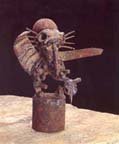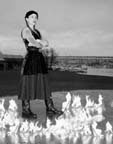Erik Reimes
|
|
2002 Art Access
The following was a review in the
Monthly Guide to the Arts
- in Seattle and Washington
Art Access
Volume 11 number 5
June 2002
Norn: In and Out of Time
|
The ad for this show is brilliant. Three provocative photographs depict artists in outdoor settings looking as confident as warriors—a pose artists need to strike these days.
Larsen—also of Burning Man Festival fame—documents
At the opening reception Erik Reime tattooed a man’s arm using a hand held needle of a girth to mend a carpet. Reime got the tattoo bug watching a version of “Mutiny on the Bounty” starring Mel Gibson. He saw Fletcher Christian and his sailors come onto Tahiti and get tattoos unlike the typical western hearts, ships and daggers. He makes his own stainless steel tools to practice ancient methods along with using modern machinery. He tattoos with rose thorns and quills, and recently studied an Inuit technique that uses a needle and thread to pull ink through the skin. I found Reime’s designs to be remarkable and his practice of fusing culture, history, artifact, and ritual to make perfect sense. He works with people for as long as one year perfecting designs based on Scandinavian petroglyphs. In a recent interview with Rik van Boeckel published in Journalistiek, Reime stated that he doesn’t consider copying other’s designs for tattoos art. “The body is important,” he said: “I don’t like to design on a piece of paper; it’s too flat - it doesn’t speak back to me.” He sees tattooing as a way to bring power into a person, and also as a way to record both the bitter and sweet of a life. “People get tattoos when they get married, divorced, go through stages,” says the artist; “They always have that record.” Reime’s exhibit consists of large—scale photographs in both color and black and white that document tattoos on their wearers. These are compelling portraits as well. In one photo a braided dragon lays along the spine of a woman whose hair is pulled aside. Flesh is often red from a session—Reime uses black ink so flesh becomes the pigment. The most traditional gallery artist here is Steffan Herrik, whose exhibit consists of sculptures and prints. Again, according to the Museum’s Nordic News, Herrick “bases his birdlike creations on a myth from Greenland called Gumozos...said to come and land on the mast head of passing ships, causing them to crash or be lost at sea.” In the ad for this show Herrick stands chest high in a frigid sea alongside such creatures. In spite of reputations of doom, Herrick’s figures—smaller for this traveling show—have humorous names: “Topgumozo,” “Disney Gumozo,” and “Bad Back.” The sculptures begin as Silicone rubber forms, are translated to wax, then cast into metal and welded. Herrick makes five or six of the same figures then manipulates them—adding mouse ears, tails and horns—in a process he likens to cloning and gene manipulation. He’s tested about 300 patinas; many here are the result of an ancient Chinese method. His prints are rich and fuzzy. The artist uses an angle grinder amongst other instruments to draw on copper. Dry point does not employ acids to etch clean; a burr of copper splashes alongside each hand-incised mark. While making plates more fragile, such burrs hold the extra ink that creates a signature, velvety effect. Herrick cuts many of his plates with shears; bird-like Gumozo figures stand clear-cut against creamy paper grounds. In an instrumental way all three Norn participants blur lines between archeology, history and art. As artist-historians, they approach the world from a place of story and passion verses, say, correct carbon dating. I find such a hybrid process an exciting prospect for the world. From the standpoint of someone not grounded in an ancient culture—Grandma Jones’ British-influenced meat and potato pie is as cultural as I get—a part of me envies artists who are. Where do third generation American visual artists like me find deeply rooted themes in such a fresh country? Steffan Herrick told me that the art he’s seen here is boring. “You have to have impressionism before you have expressionism,” he said, which I thought was amazing coming from a guy who thinks in Danish. I took his comment to mean that artists here don’t allow inspiration to roam inside of them long enough before foisting it on the rest of us. Molly Norris Curtis Molly Norris Curtis is an artist and curator who shows her work locally at Atelier 31 in Kirkland, WA. Norn: In and Out of Time is on view through July 14. Nordic Heritage Museum is located at 3014 NW 67th Street in Seattle. The museum is open Tues-Sat 10 A.M.-4 P.M. and Sun 12-4 P.M. • (206) 789-5707 |
Kontakt Erik Reime: erik@reime.dk
 Astrid Larsen is a
half-Danish fire artist based in Seattle. Steffan Herrik is a printmaker
and sculptor living in Denmark on the island of Fyn. Erik Reime has a
tattoo studio also in Denmark. These friends have been gathered together
for an exhibit inspired by a shared love of ancient Scandinavian history
and myth, a movement Ms. Larsen refers to as “experiment archeology.”
Astrid Larsen is a
half-Danish fire artist based in Seattle. Steffan Herrik is a printmaker
and sculptor living in Denmark on the island of Fyn. Erik Reime has a
tattoo studio also in Denmark. These friends have been gathered together
for an exhibit inspired by a shared love of ancient Scandinavian history
and myth, a movement Ms. Larsen refers to as “experiment archeology.” a project she worked on in Lejre, Denmark, the site of an archeological
dig. According to the Nordic News, she was given 3-4 fields in which to
create land sculptures of 100-200 feet that she then set on fire. She
chose images based on artifacts and created modern petroglyphs by
incising paths.
a project she worked on in Lejre, Denmark, the site of an archeological
dig. According to the Nordic News, she was given 3-4 fields in which to
create land sculptures of 100-200 feet that she then set on fire. She
chose images based on artifacts and created modern petroglyphs by
incising paths.  Shape of land
influenced where she ‘drew’ her iconic harpoons and dogs. Denmark is
a flat, glacier-formed country and Larsen worked around mounds of Bronze
Age graves covered with earth and grown over. At night thirty people
jogged along each of her drawings hoisting torches. By using a
three-minute camera exposure the photos show bands of fire flowing
through air. Larsen was inspired by environmental artists from the 60s
and 70s as well: Walter de Maria’s “Lightening Field” and Robert
Smithson’s “Spiral Jetty.”
Shape of land
influenced where she ‘drew’ her iconic harpoons and dogs. Denmark is
a flat, glacier-formed country and Larsen worked around mounds of Bronze
Age graves covered with earth and grown over. At night thirty people
jogged along each of her drawings hoisting torches. By using a
three-minute camera exposure the photos show bands of fire flowing
through air. Larsen was inspired by environmental artists from the 60s
and 70s as well: Walter de Maria’s “Lightening Field” and Robert
Smithson’s “Spiral Jetty.”